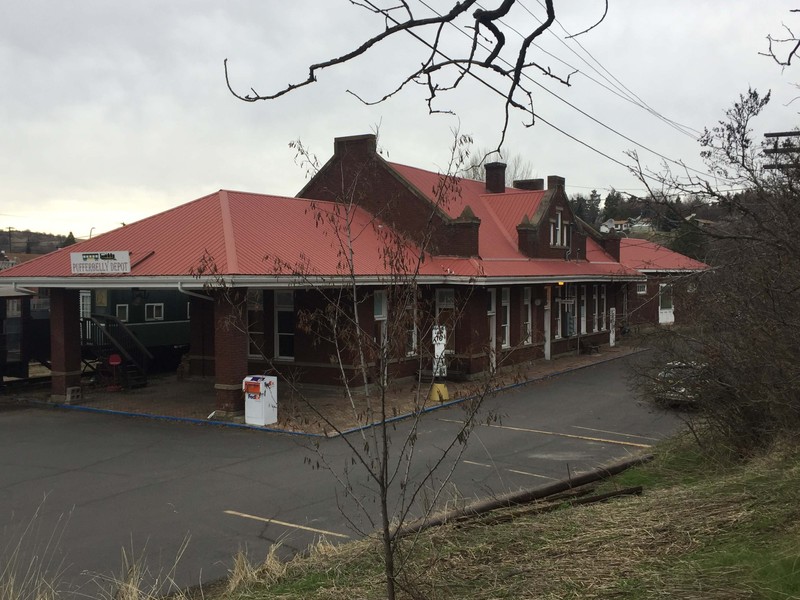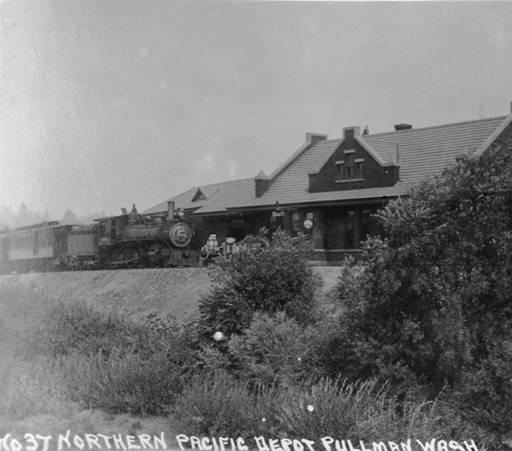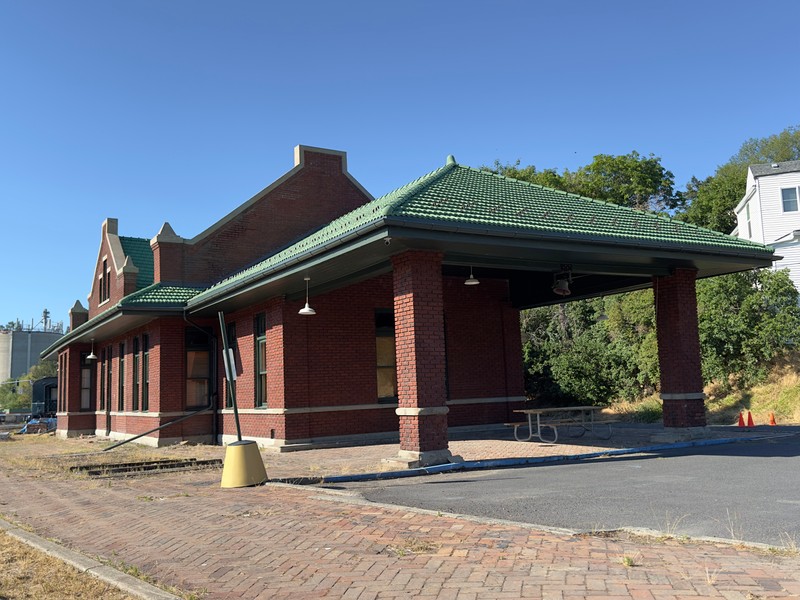Northern Pacific Railroad Depot (Pullman Depot Heritage Center)
Introduction
Text-to-speech Audio
In June 1916, the Northern Pacific Railroad replaced a smaller wooden structure with a distinguished passenger depot befitting the first transcontinental railroad to span the Pacific Northwest. The new station featured wrought iron grillwork, gabled parapets, brass fittings, oak furniture, and marble restrooms-some of which are still visible in the reconfigured lobby. During the first half of the twentieth century, the "Cougar Special" train departed from the depot and brought Washington State College students to and from Seattle. The Whitman County Historical Society purchased the property in 2018 and formed the Pullman Depot Heritage Center.
Images
View of the former Northern Pacific Railroad Depot, taken February 2018.

A train pulled to a stop in front of the depot, taken ca. 1920 by Artopho Studio. Courtesy WSU Special Collections. http://content.libraries.wsu.edu/cdm/compoundobject/collection/pullman/id/1131/show/23/rec/1


Backstory and Context
Text-to-speech Audio
The first railroad to arrive in Pullman was established by the Oregon Railway and Navigation Company in 1885. The Northern Pacific Railroad arrived soon after, establishing the Spokane and Palouse branch line in 1887.1 The Northern Pacific route ran north-south through Pullman and connected the budding town with Spokane to the north and Genesee, Idaho, to the south. In 1890, the branch was extended further south to Lewiston, Idaho.
When the Northern Pacific branch line through Pullman was completed, a wooden structure served as the depot for the railroad. In May 1916, the Northern Pacific called for bids for the construction of a new, larger depot. Sound Construction from Seattle was awarded the bid.2 The owners, John Hastie and Mr. Dugan, also constructed Bryan and College halls on the Washington State College campus (now WSU) under the name Hastie & Dugan.3 The old wooden depot was sawn in two and the track was moved 8 feet toward the river on to a new railroad bed.
Constructed for an estimated $40,000, the new depot featured an exterior of Dakota pressed brick with an interior showcasing gleaming marble and polished wood. Upon its opening, the depot unveiled a central ticket and express office with the latest technology in telegraph fixtures and electric signaling. Other interior rooms included a smoking room, waiting room, men’s and women’s restrooms, and a baggage room.4
The new depot opened to much fanfare on March 9, 1917.5 Mayor John W. Matthews presided over the festivities, which kicked off after the 8 o’clock train left for Lewiston. Flags and bunting decorated the building. In addition to music and treats, including an impressive 2,500 individual fruitcakes prepared by the dining car staff, the nearby artesian well was uncapped to turn it into a foundation. Numerous railroad officials were present to christen the new building. These officials included including A.D. Charlton (assistant general passenger agent out of Portland, Oregon), H.J. Titus (superintendent of the dining car department out of St. Paull, Minn.), B.C. Pettibone (general baggage agent, St. Paul, Minn.), W.H. Ude (city passenger agent of Spokane), M.A. Berg (traveling passenger agent), and C.R. Lonergan (general agent, Spokane).
Today, the building, no longer a train depot, is being restored, and developed into a regional heritage center.
Sources
1. Julia H. Bush, “Pullman Early History 1871-1892,” (2011), available through the City of Pullman’s website, www.pullman-wa.gov
2. "Seattle Contractors Will Build N.P. Depot," The Pullman Herald, May 26, 1916.
3. “Will Rush Work on New N.P. Depot,” The Pullman Herald, June 23, 1916.
4. “$40,000 Northern Pacific Depot Comes to Pullman,” The Pullman Herald, May 5, 1916: 1.
5. “Opening of New N.P. Depot Attracts Tremendous Crowd,” The Pullman Herald, March 16, 1917: 1.
